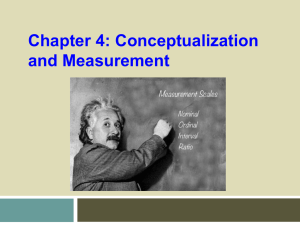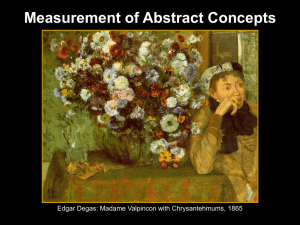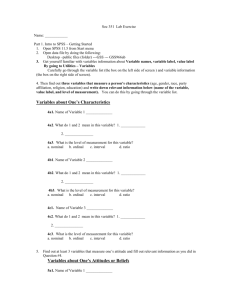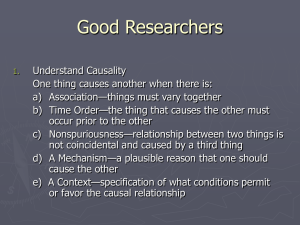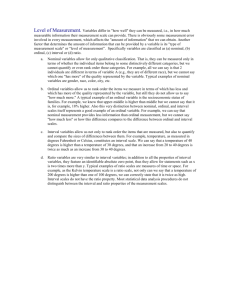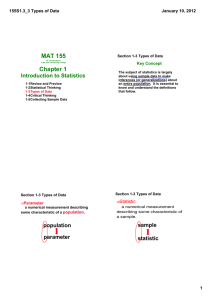concepts
advertisement
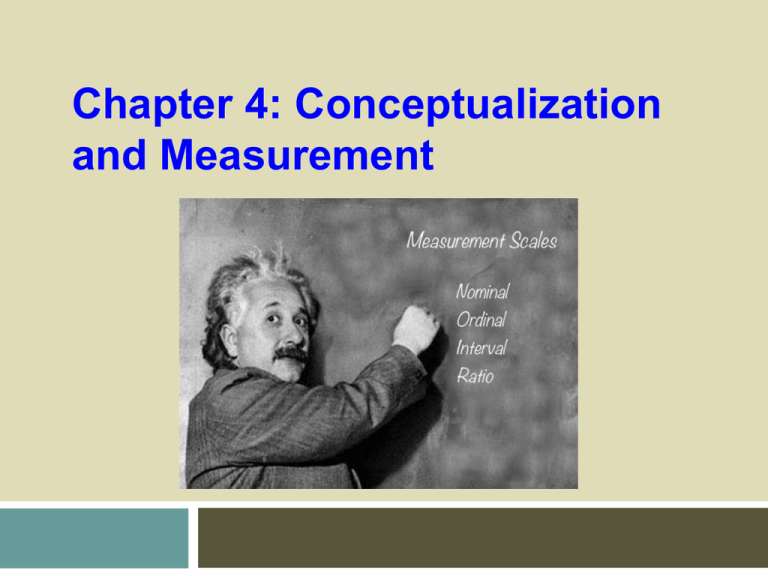
Chapter 4: Conceptualization and Measurement Measuring Anything that Exists Measurement – Careful, deliberate observations of the real world For the purpose of describing objects and events in terms of the Attributes composing the variable Conceptualization Process: Of specifying what we mean when we use particular terms in research. Conceptualization process creates an agreedon meaning for a concept For the purposes of research Conceptions, Concepts, and Reality Conceptualization – The mental process whereby fuzzy and imprecise notions (concepts) are made more specific and precise. How would you conceptualize… Prejudice? Compassionate? Concepts • Mental representations • Typically based on experience • • • • Concepts can be of real phenomena Dogs, Clouds, Pain, Cars, Cell phones Concepts can be of agree-upon phenomena Truth, Beauty, Justice, Prejudice, Value, Concepts as Constructs Concepts are constructs derived by mutual agreement from mental images. Conceptions summarize collections of seemingly related observations and experiences. Things that can be Measured Three classes of things can be measured 1. Direct Observables 2. Indirect Observables 3. Constructs Things that can be Measured • Three classes of things can be measured • 1. Direct observables Height, weight, color, etc. 2. Indirect observables Questionnaires Information on Gender, age, income, etc. Things that can be Measured 3. Constructs Theoretical creations based on observations Cannot be seen either directly or indirectly, such as: IQ Leisure Satisfaction Environmental Values Indicators and Dimensions Indicator Concept or direct observable used to measure a construct. example, consider a person’s extent of agreement with this statement: For “I am a person of worth” As an indicator of person’s self-esteem Indicators Rosenberg’s self-esteem scale contains ten statements used to measure self-esteem. Each statement assumed to accurately measure self-esteem as an indicator of it. Indicators Rosenberg’s self-esteem scale contains ten statements used to measure self-esteem. Each statement assumed to accurately measure self-esteem as an indicator of it. (Handout) Gallup Index of Leading Religious Indicators 1. Believe in God 2. Religious preference 3. Member of a church 4. Attended church last 7 days 5. Religion very important in life 6. Religion answers problems 7. High confidence in organized religion 8. Give high ratings to ethical standards of clergy Indicators: How would you measure… Political party affiliation? Age? Grade point average? Satisfaction Religious with college? affiliation? Dimensions Constructs sometimes have multiple dimensions, each with indicators. For example: The construct Locus-of-Control Three dimensions: Internal External Powerful others 1/27 Identify Indicators & Dimensions Identify appropriate indicators and dimensions for… College success Political activity Poverty Binge Fear drinking of crime Nominal, and Operational Definitions Nominal definition: Assigned to a term without any claim that the definition represents a “real” entity. Name Operational definition: Specifies precisely how a concept will be measured Levels of Measurement • Level of Measurement=Mathematical precision with which values of a variable can be expressed. • Nominal level of measurement: • Qualitative • No mathematical interpretation Levels of Measurement Quantitative levels of measurement: Ordinal Interval Ratio Progressively more precise mathematically Nominal Measures (Labels) Identifies variables whose values have no mathematical interpretation Categories If are not ordered only two categories: Referred to as a dichotomous or “Dummy” variable Examples of Nominal Measures Ordinal Measures Categorical--Some categories are higher than others. For example: Income tax brackets Social class Levels of education Ordinal Measures Cannot measure the distance between categories Only which is higher or lower Cannot say that someone is twice as educated as someone else Can be used as a dependent variable Example: Ordinal Measures When attributes can be rank-ordered… Distances between attributes do not have any meaning For example : code Educational Attainment as 0=less than H.S. 1=some H.S. 2=H.S. degree 3=some college 4=college degree 5=post college Is the distance from 0 to 1 the same as 3 to 4? Example: Ordinal Measures Interval Measures Called scalar or index variables Provide scale or index to measure between levels Can measure which is higher or lower and how much Measured between points on a scale with even units Example: Temperature in Fahrenheit or Celsius Example: Interval Measures When distance between attributes has meaning, for example, temperature (in Fahrenheit) Distance from 30-40 degrees = Distance from 70-80 degrees Used for a variety of statistical analyses: Central tendency can be measured by mode, median, or mean Standard deviation can be calculated Cannot calculate ratios Index of Feminist Attitudes An index of their feminist attitudes was calculated from 6 questions, but the index had no absolute zero. Do you agree or disagree with the following statements? (SD =1, D=2, N=3, A=4, SA=5) 1. A woman should have the same job opportunities as a man. 2. Men should respect women more than they currently do. 3. America should pass the Equal Rights Amendment. 4. Women should be considered as seriously as men as candidates for the Presidency of the United States. 5. Doctors need to take women's health concerns more seriously. 6. Women have been treated unfairly on the basis of their gender throughout most of human history. Feminist Attitude index = 30 (highest score possible) Feminist Attitude index = 5 (lowest score possible) Ratio Level Measurement Similar to interval level Can measure distance between two points But can do so in absolute terms Ratio measures have a true zero (unlike interval measures) Example, can say that someone is twice as rich as someone else based on the value of their assets. To have no money is based on a starting point of zero Ratio Level Measurement Has an absolute zero that is meaningful Can construct a meaningful ratio (fraction), for example, number of clients in past six months It is meaningful to say that “...we had twice as many clients in this period as we did in the previous six months. Ratio Level Measurement Ratio scales are the ultimate when it comes to measurement scales They tell us about the order They tell us the exact value between units AND also have an absolute zero Allows for a wide range of both descriptive and inferential statistics Types of Comparisons That Can Be Made With Different Levels of Measurement Measurement Hierarchy RATIO STRONGEST INTERVAL ORDINAL NOMINAL WEAKEST

